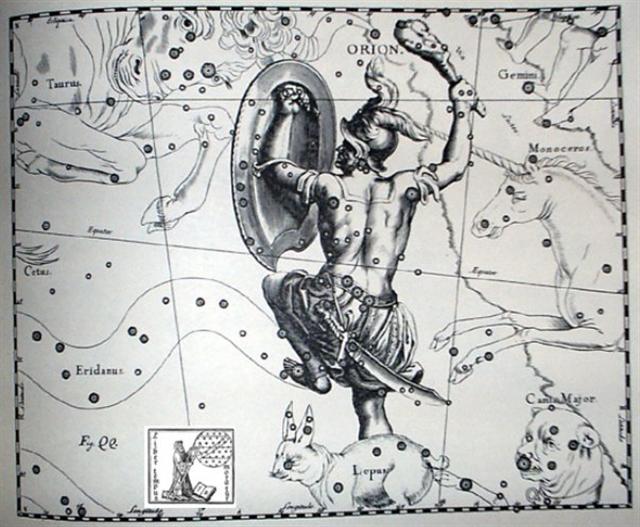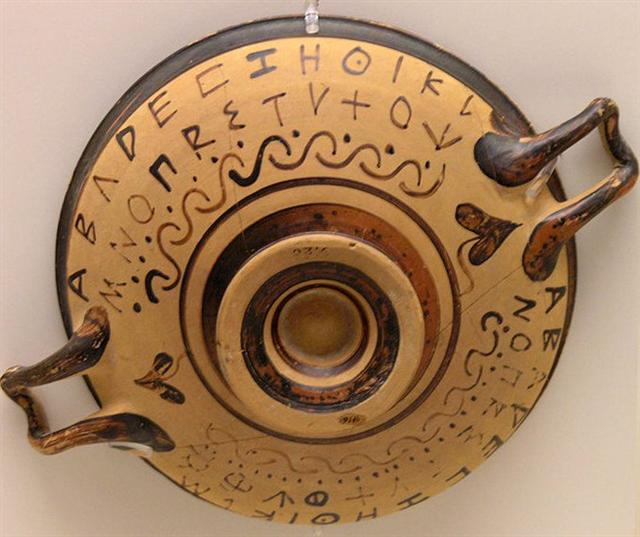Spica is the brightest of the stars in Virgo, who has her left hand just below the ecliptic path of Sun (when she is looking down on us). Possibly this was a reason for thinking Sun - the ruling light in the sky - had to disappear (go down) for a while:
Spica means ear (spike) and Virgo is normally depicted with such in her hand - a sign of the next generation (hua):
The henua (earth) sign in Ga5-30 exhibits a growth sign in front. The sign in form of an open henua - maybe a short form of he-nua-hine, the old woman - probably indicates 'not visible' (referring to the ruler in charge):
... Instead of that old, dark, terrible drama of the king's death, which had formerly been played to the hilt, the audience now watched a solemn symbolic mime, the Sed festival, in which the king renewed his pharaonic warrant without submitting to the personal inconvenience of a literal death. The rite was celebrated, some authorities believe, according to a cycle of thirty years, regardless of the dating of the reigns; others have it, however, that the only scheduling factor was the king's own desire and command. Either way, the real hero of the great occasion was no longer the timeless Pharaoh (capital P), who puts on pharaohs, like clothes, and puts them off, but the living garment of flesh and bone, this particular pharaoh So-and-so, who, instead of giving himself to the part, now had found a way to keep the part to himself. And this he did simply by stepping the mythological image down one degree. Instead of Pharaoh changing pharaohs, it was the pharaoh who changed costumes. The season of year for this royal ballet was the same as that proper to a coronation; the first five days of the first month of the 'Season of Coming Forth', when the hillocks and fields, following the inundation of the Nile, were again emerging from the waters. For the seasonal cycle, throughout the ancient world, was the foremost sign of rebirth following death, and in Egypt the chronometer of this cycle was the annual flooding of the Nile. Numerous festival edifices were constructed, incensed, and consecrated; a throne hall wherein the king should sit while approached in obeisance by the gods and their priesthoods (who in a crueler time would have been the registrars of his death); a large court for the presentation of mimes, processions, and other such visual events; and finally a palace-chapel into which the god-king would retire for his changes of costume. Five days of illumination, called the 'Lighting of the Flame' (which in the earlier reading of this miracle play would have followed the quenching of the fires on the dark night of the moon when the king was ritually slain), preceded the five days of the festival itself; and then the solemn occasion (ad majorem dei gloriam) commenced. The opening rites were under the patronage of Hathor. The king, wearing the belt with her four faces and the tail of her mighty bull, moved in numerious processions, preceded by his four standards, from one temple to the next, presenting favors (not offerings) to the gods. Whereafter the priesthoods arrived in homage before his throne, bearing the symbols of their gods. More processions followed, during which, the king moved about - as Professor Frankfort states in his account - 'like the shuttle in a great loom' to re-create the fabric of his domain, into which the cosmic powers represented by the gods, no less than the people of the land, were to be woven ... ... The king, wearing now a short, stiff archaic mantle, walks in a grave and stately manner to the sanctuary of the wolf-god Upwaut, the 'Opener of the Way', where he anoints the sacred standard and, preceded by this, marches to the palace chapel, into which he disappears. A period of time elapses during which the pharaoh is no longer manifest. When he reappears he is clothed as in the Narmer palette, wearing the kilt with Hathor belt and bull's tail attatched. In his right hand he holds the flail scepter and in his left, instead of the usual crook of the Good Shepherd, an object resembling a small scroll, called the Will, the House Document, or Secret of the Two Partners, which he exhibits in triumph, proclaiming to all in attendance that it was given him by his dead father Osiris, in the presence of the earth-god Geb. 'I have run', he cries, 'holding the Secret of the Two Partners, the Will that my father has given me before Geb. I have passed through the land and touched the four sides of it. I traverse it as I desire.' ... The 'split up' maitaki in Eb6-1 has at left and right the same type of 'sky domes' as those to the left and and right of pharaoh inside his temple:
The Ear is the opposite of the Eye, a sense organ to be used in the dark, when the sunlight ('Leo') has disappeared. A spike of corn hides new life. Counting from the star Saiph (the 'Sword' of Sun in his Orion 'costume') and from 'zayin' Leporis (Moon as a Hare) there are 117 days to the starless Ga5-30. 117 = 9 * 13 and 472 - 117 = 355.
Heze (at Ga6-1) is ζ Virginis, the star in the Virgin's lap. 6 * 1 = 6 and there are 7 times 10 days to the solstice. Line a6 is evidently beginning with the origin of new life:
... Zeta (uppercase Ζ, lowercase ζ; Greek: ζήτα ... is the sixth letter of the Greek alphabet. In the system of Greek numerals, it has a value of 7. It was derived from the Phoenician letter Zayin [see letter number 7 on the bowl above]. Letters that arose from zeta include the Roman Z and Cyrillic З ... Zayin (also spelled Zain or Zayn or simply Zay) is the seventh letter of many Semitic abjads ... It represents the sound [z]. The Phoenician letter appears to be named after a sword or other weapon. (In Biblical Hebrew, 'Zayin' means sword, and the verb 'Lezayen' means to arm. In modern Hebrew, 'zayin' means penis and 'lezayen' is a vulgar term which generally means to perform sexual intercourse and is used in a similar fashion to the English word fuck, although the older meaning survives in 'maavak mezuyan' (armed struggle) and 'beton mezuyan' (armed, i.e., reinforced concrete). The Proto-Sinaitic glyph according to Brian Colless may have been called ziqq, based on a hieroglyph depicting a 'manacle' ... Moe in Ga6-6 clearly indicates the beginning of a new season. From moe at the Heavenly Gate star (ζ Tauri) there are 126 days (18 weeks):
In 'October 21 there could be a representation of the old woman in the Moon, who is sitting down in her darkness (61 * 0 = 0) in order to 'light the fire of her oven' (te Nuahine ká umu a ragi kotekote):
The nawaa Suhail has just ended:
... In the inscriptions of Dendera, published by Dümichen, the goddess Hathor is called 'lady of every joy'. For once, Dümichen adds: Literally ... 'the lady of every heart circuit'. This is not to say that the Egyptians had discovered the circulation of the blood. But the determinative sign for 'heart' often figures as the plumb bob at the end of a plumb line coming from a well-known astronomical or surveying device, the merkhet. Evidently, 'heart' is something very specific, as it were the 'center of gravity' ... See Aeg.Wb. 2, pp. 55f. for sign of the heart (ib) as expressing generally 'the middle, the center'. And this may lead in quite another direction. The Arabs preserved a name for Canopus - besides calling the star Kalb at-tai-man ('heart of the south') ... Suhail el-wezn, 'Canopus Ponderosus', the heavy-weighing Canopus, a name promptly declared meaningless by the experts, but which could well have belonged to an archaic system in which Canopus was the weight at the end of the plumb line, as befitted its important position as a heavy star at the South Pole of the 'waters below'. Here is a chain of inferences which might or might not be valid, but it is allowable to test it, and no inference at all would come from the 'lady of every joy'. The line seems to state that Hathor (= Hat Hor, 'House of Horus') 'rules' the revolution of a specific celestial body - whether or not Canopus is alluded to - or, if we can trust the translation 'every', the revolution of all celestial bodies. As concerns the identity of the ruling lady, the greater possibility speaks for Sirius, but Venus cannot be excluded; in Mexico, too, Venus is called 'heart of the earth'. The reader is invited to imagine for himself what many thousands of such pseudo-primitive or poetic interpretations must lead to: a disfigured interpretation of Egyptian intellectual life ... 294 - 176 = 118 (= 4 * 29˝):
Furthermore, there is a change in the tresses of Pachamama (The Earth Mother) - carved into the back side of this marvellous stone statue forever and for everyone to see - which occurs at a time close to 214: ... The signs in the tresses of Pachamama are distributed as 214.5 + 185.5 = 400: 
What looks like a tamaiti (child) glyph arrives in Ga6-12, where the star Syrma marks the left knee of Virgo. Significantly this star is not mentioned as the ruling star at the manzil Syrma - knees are not suitable for rulers, instead their function is to be flexible.
Obviously the bird in Ga6-19 is of the same general type as that in Ga5-8, but this one is not 'giving birth' to an egg but to something else.
The evidence suggests the creator of the text knew π and ο in Bootes were separated by the same distance as π and ο in Virgo. No 'eye' (mata) has been drawn for the haú glyph in Ga6-21, probably a sign of dark times, and a fat rau hei figure follows. The Auva manzil is over:
The Simak manzil is connected with the star Spica (24 glyphs earlier) and Auva is referring to Minelauva (158 - 139 = 19 glyphs earlier, at Ga5-21). Another rau hei arrives 3 days later. This one presumably represents Sun, because it is thinner and has only one 'wing'. It coincides with the λ star in Lupus (the Wolf), and the basic idea could be similar to the 'Opener of the Way' (Upwaut) in ancient Egypt:
The first Wolf star in my list (ι Lupi) is at 'tamaiti' in Ga6-12 and the last such star is θ Lupi arriving at the true tamaiti 27 days later, precisely where the henua calendar just has ended. The 'Wolf season' thus seems to cover ca 4 weeks.
The π day in the Gregorian calendar is November 10. | ||||||||||||||||||||||||||||||||||||||||||||||||||||||||||||||||||||||||||||||||||||||||||||||||||||||||||||||||||||||||||||||||||||||||||||||||||||||||||||||||||||||||||||||||||||||||||||||||||||||||||||||||||||||||||||||||||||||||||||||||||||||||||||||||||||||||||||||||||||||||||||||||||||||||||||||||||





























